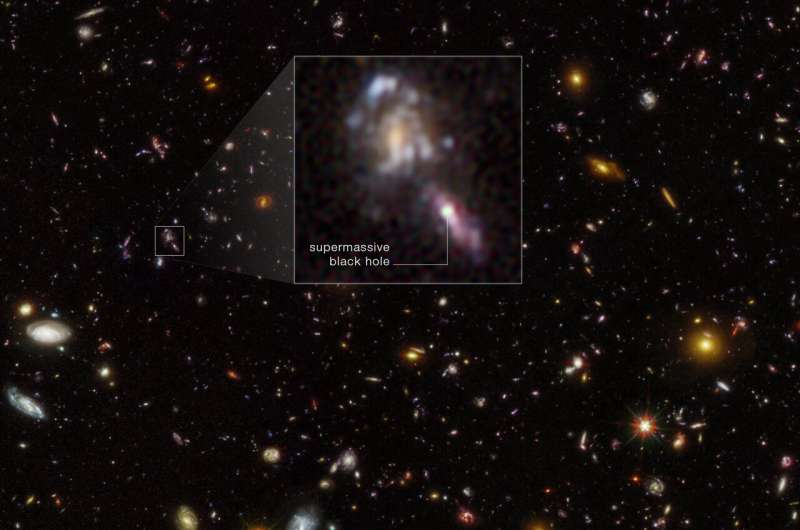
September 17, 2024 by ESA/Hubble Information Centre
Collected at: https://phys.org/news/2024-09-hubble-black-holes-early-universe.html
With the help of NASA’s Hubble Space Telescope, an international team of researchers led by scientists in the Department of Astronomy at Stockholm University has found more black holes in the early universe than has previously been reported. The new result can help scientists understand how supermassive black holes were created.
Currently, scientists do not have a complete picture of how the first black holes formed not long after the Big Bang. It is known that supermassive black holes, that can weigh more than a billion suns, exist at the center of several galaxies less than a billion years after the Big Bang.
“Many of these objects seem to be more massive than we originally thought they could be at such early times—either they formed very massive or they grew extremely quickly,” said Alice Young, a Ph.D. student from Stockholm University and co-author of the study published in The Astrophysical Journal Letters.
Black holes play an important role in the lifecycle of all galaxies, but there are major uncertainties in our understanding of how galaxies evolve. In order to gain a complete picture of the link between galaxy and black hole evolution, the researchers used Hubble to survey how many black holes exist among a population of faint galaxies when the universe was just a few percent of its current age.
Initial observations of the survey region were re-photographed by Hubble after several years. This allowed the team to measure variations in the brightness of galaxies. These variations are a telltale sign of black holes. The team identified more black holes than previously found by other methods.

The new observational results suggest that some black holes likely formed by the collapse of massive, pristine stars during the first billion years of cosmic time. These types of stars can only exist at very early times in the universe, because later-generation stars are polluted by the remnants of stars that have already lived and died.
Other alternatives for black hole formation include collapsing gas clouds, mergers of stars in massive clusters, and “primordial” black holes that formed (by physically speculative mechanisms) in the first few seconds after the Big Bang. With this new information about black hole formation, more accurate models of galaxy formation can be constructed.
“The formation mechanism of early black holes is an important part of the puzzle of galaxy evolution,” said Matthew Hayes from the Department of Astronomy at Stockholm University and lead author of the study. “Together with models for how black holes grow, galaxy evolution calculations can now be placed on a more physically motivated footing, with an accurate scheme for how black holes came into existence from collapsing massive stars.”
Astronomers are also making observations with NASA’s James Webb Space Telescope to search for galactic black holes that formed soon after the Big Bang, to understand how massive they were and where they were located.
More information: Matthew J. Hayes et al, Glimmers in the Cosmic Dawn: A Census of the Youngest Supermassive Black Holes by Photometric Variability, The Astrophysical Journal Letters (2024). DOI: 10.3847/2041-8213/ad63a7
Journal information: Astrophysical Journal Letters

Leave a Reply